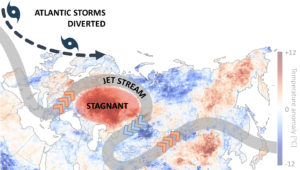Persistent Summer Extremes
In this project we unite state-of-the-art climate models with novel causal discovery algorithms
Research goal
In PERSIST, we study mid-latitude summer circulation and its influence on weather persistence focusing on the most high-impact, persistent summer extremes. We quantify persistence, their local and remote drivers in past, present and future climates, focusing on the United States and Europe, regions critical for global food production.
Mechanisms of Persistent Summer Extremes
Often persistent summer extremes are caused by stagnant large-scale circulation patterns. Summer storm tracks have weakened over the last 40 years, related to enhanced warming of polar regions, which favors the buildup of long hot-and-dry periods over land. Also positive feedbacks between land and atmosphere are important drivers of hot-dry extremes.

Schematic representation of the circulation during the Russian heatwave of 2010.
Research question
Main research questions of PERSIST are:
* Is climate change making summer weather more persistent?
* How important is persistence of extreme weather for societal impacts, in particular agriculture?
* What is the relative importance of wavy Jetstream patterns versus land-atmosphere feedbacks?
Method
In this project we unite state-of-the-art climate models (EC-Earth) with machine learning approaches including novel causal discovery algorithms (CDAs). With CDAs we aim at disentangling the causal drivers of persistent extremes from observational datasets. Applying CDAs to both observational and climate model data, we can understand how-well models reproduce the relevant physics and how these causal drivers change in future warmer climates. The project aims to have a direct societal impact by improving long-lead predictions of persistent extreme events by using machine learning methods.
Contributors:
- Dr. Dim Coumou (VU) – project leader (NWO-VIDI Persistent Summer Extremes)
- Dr. Frank Selten (from the Royal Netherlands Meteorological Institute, KNMI)
- Phd. Fei Luo (VU)
- Phd. Sem Vijverberg (VU)

